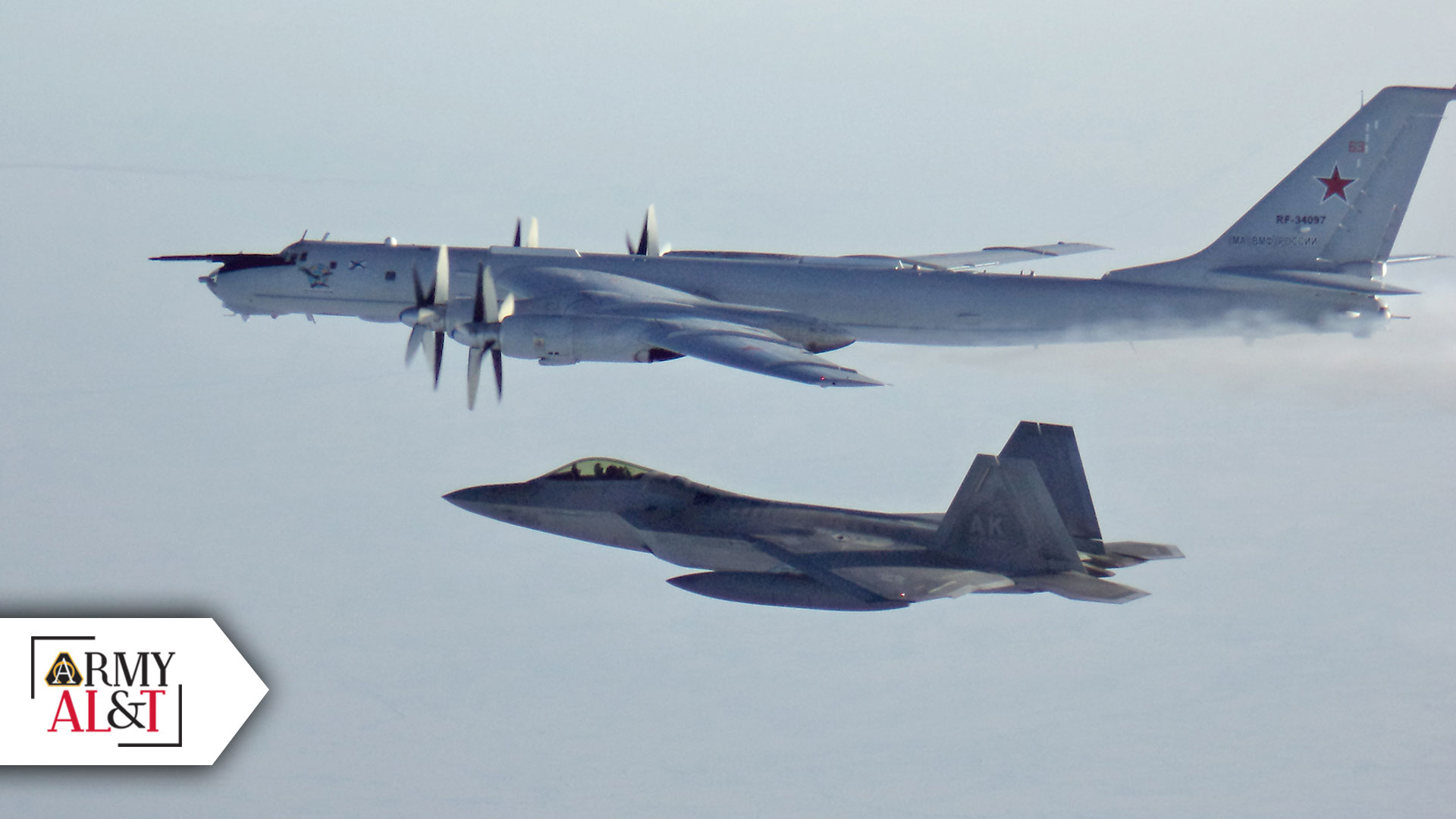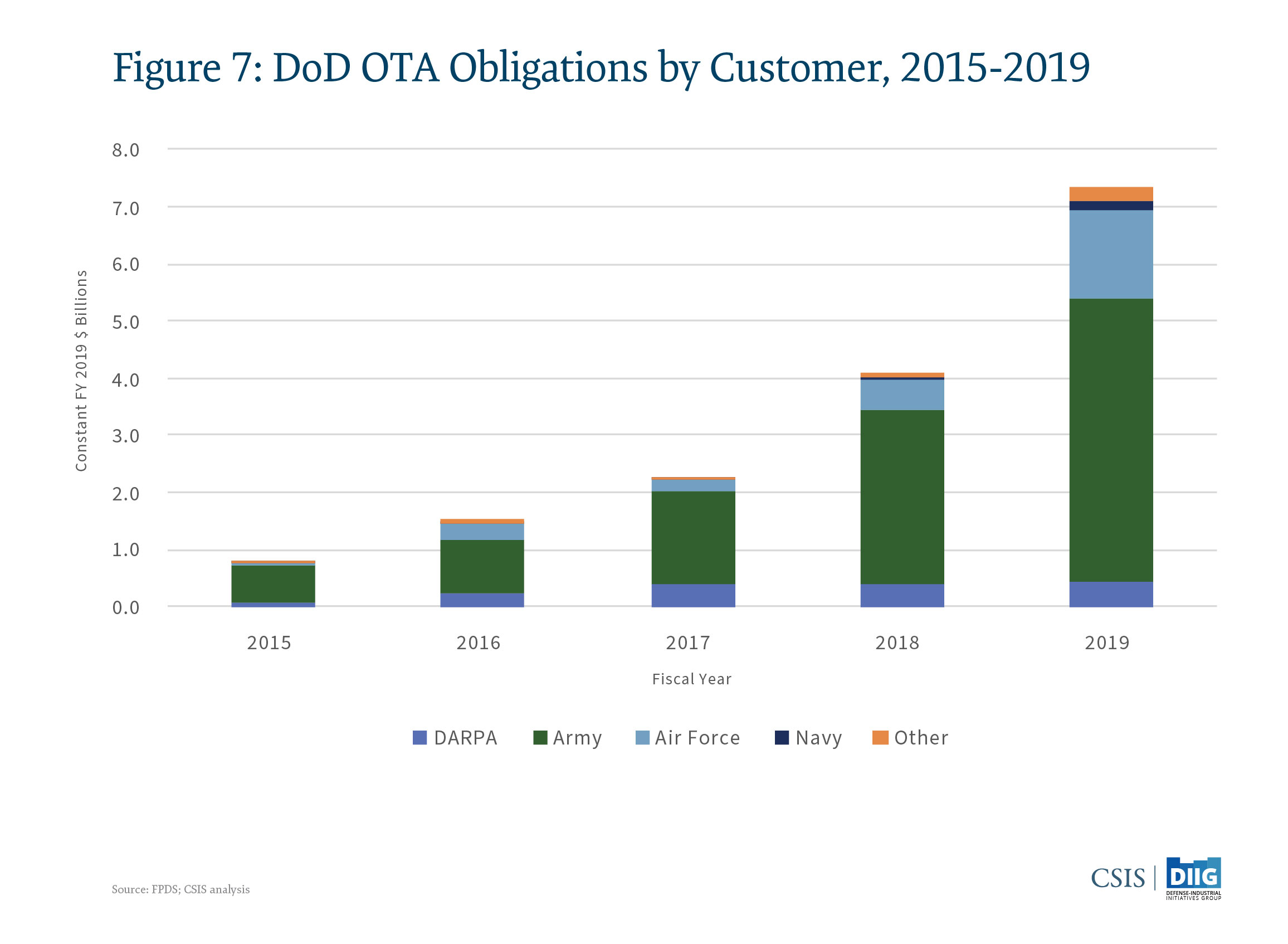
NEW COLD WAR?: If we’re entering a new cold war, it’s not the same as the post-World War II version. China would appear to be the main foe, although Russia remains a challenging adversary. In March 2020, North American Aerospace Defense Command F-22s, CF-18s, supported by KC-135 Stratotanker and E-3 Sentry AWACS aircraft, intercepted two Russian Tu-142 maritime reconnaissance aircraft entering the Alaskan Air Defense Identification Zone. (Photo by North American Aerospace Defense Command)
To regain its technological warfighting edge, the United States must not only allow commercial industry to bid on work, it must also recruit and encourage participation.
by Dave Riel
As I traveled the smooth, newly constructed road to the small Ugandan village that our medical mission team was serving that week—and remembering the awful, bumpy ride to Bukeka only 18 months before—I questioned my Ugandan host, Ronnie, “When did this happen?” His answer surprised me.
The Chinese had built it within the last year—one of many economic outreaches that Beijing has initiated under its Belt and Road Initiative. As highlighted by the 2018 summary of the National Defense Strategy (NDS), China “is leveraging military modernization, influence operations, and predatory economics to coerce neighboring countries to reorder the Indo-Pacific region [and others] to their advantage.”
Growing tensions between China and the United States, along with burgeoning Chinese assertiveness and military capabilities, propel us with an urgency to emerge from what the NDS describes as “a period of strategic atrophy” and “a security environment more complex and volatile than any we have experienced in recent memory.”

MILITARY OPTION: China’s “doctrine of ‘civil-military fusion’ requires that any commercial or academic technological advancement with military implications be shared with” the People’s Liberation Army, writes Michèle Flournoy, former undersecretary of defense for policy. As China recovers from the COVID-19 pandemic, about 2,000 Chinese and foreign enterprises prepare to participate in the China International Fair for Trade in Services, held from May 28 to June 1 each year in Beijing. (Photo by Lintao Zhang, Getty Images)
As Michèle Flournoy, former undersecretary of defense for policy, pointed out in a June 2020 article in Foreign Affairs, “[I]t will take a concerted effort to rebuild the credibility of U.S. deterrence in order to reduce the risk of a war that neither side seeks.” It is this reprioritization from defeating terrorism to focusing on inter-state strategic competition that drives our acquisition priority from the early 2010s’ “better buying power” to today’s “speed of relevance.”
So, are we entering a new cold war? Perhaps, but this is not yesteryear’s Cold War. Our only interaction with Russia (still a challenging adversary) and its Warsaw Pact allies was government to government. We didn’t share much commerce. It was like two clenched fists bumping into each other as each country searched for the next technological breakthrough. Times have changed. Since what has been known as the “Last Supper,” in 1993, when then-Secretary of Defense Les Aspin advised the CEOs of our major defense industry partners to consolidate because there wouldn’t be a big enough defense budget to support them all, major defense companies have eroded from 107 at the end of the Cold War to just five by the late 1990s.
IS MORE BETTER?
Yet is multiplying the number of defense industry companies the answer to our goals? No, probably not. The world has changed and is more complex. Unlike two clenched fists, America and China have a much more complex relationship, tightly intertwined economically, while separated doctrinally. As Thomas Friedman notes in his book “The World is Flat,” if Walmart were its own country, it’d be China’s eighth largest trading partner, surpassing Canada and Australia. Further complicating the scenario is that this global economic race now drives technology. It used to be that military technological advances drove overall technology advancement—the internet and GPS; for example—but the commercial marketplace now dominates technology. If our nation is to maintain the technological superiority needed by our Soldiers on the battlefield and the deterrence needed for diplomacy, we must capitalize on commercial advances.
Since the early 2018 release of NDS, the acquisition community has established as its primary objective the production of war-winning capabilities at the speed of relevance. Each of the military branches’ service acquisition executives have prioritized speed. Dr. Bruce Jette, the former assistant secretary of the Army for acquisition, logistics and technology, has indicated that we must “maximize the use of law and policy in order to rapidly prototype, produce and field products.”
The Adaptive Acquisition Framework, described by the Honorable Ellen Lord, the former undersecretary of defense for acquisition and sustainment (USD A&S), as “the most transformational acquisition policy change we’ve seen in decades,” was introduced to “enable innovative acquisition approaches that deliver warfighting capability at the speed of relevance.” The framework establishes multiple pathways to achieve that speed. In the National Defense Authorization Act (NDAA) for the 2016 fiscal year, Congress authorized the use of middle tier of acquisition, designed to provide warfighters with new and proven innovative technologies within five years. In the 2020 NDAA, Congress authorized DOD to take advantage of agile commercial software development processes to quickly develop, field and continually upgrade software solutions. Even the stodgy, traditional pathway, now referred to as major-capability acquisition, with its five phases and multiple decision points, embraces as its first priority the “speed of delivery.”
As the NDS notes, “New commercial technology will change society and, ultimately, the character of war. That many technological developments will come from the commercial sector means that state competitors and non-state actors will also have access to them, a fact that risks eroding the conventional overmatch to which our nation has grown accustomed.” Recognizing the importance of speed and the dominance of the commercial realm’s technology progress, the question becomes how we get it to our Soldiers quickly. How do we tap into, adapt and adopt the innovation being developed by commercial entities at a rate faster than China and Russia can?
MORE NEEDS DOING
We have taken some good, necessary steps in allowing commercial companies to more easily engage in contracting with our bureaucratic acquisition and contracting policies, such as increased use of other-transaction authority. However, China has a distinct advantage to tapping into its own advancing commercial technology, as Flournoy noted in her Foreign Affairs piece. China’s “doctrine of ‘civil-military fusion,’ ” she wrote, “requires that any commercial or academic technological advancement with military implications be shared with the [People’s Liberation Army].”

DIFFERENT PORTFOLIOS: Unlike the U.S. defense industry, which produces most of its revenue strictly from defense, China’s top defense companies are also heavily involved in commercial enterprises. (Graphic by U.S. Army Acquisition Support Center, statistics from Defense News and the International Institute for Strategic Studies)
A survey of the world’s top defense contractors shows America with the top five defense revenue-producing companies in the world. However, in the American economic model, with the exception of the Boeing Co., typically yields a distinct line between defense and commercial companies. The world’s No. 1 defense revenue-producing company, Lockheed Martin, garners 95 percent of its revenue from defense, with the other top companies between 75 percent and 94 percent. China contradicts this model. With five companies in the world’s top 15 for defense revenue, Chinese companies are also heavily involved in commercial enterprises, with only 20 to 38 percent of their revenue being generated by defense. This provides for an easier opportunity for Chinese companies to transition advanced commercial technology into defense products.
If we are to retain our overmatch capabilities, we will need the advanced technologies being developed by our most innovative commercial companies. We must stop simply providing ways that allow commercial companies to provide defense products. We must develop more creative ways to actively attract and encourage these world-leading technology companies into providing our Soldiers the war-winning products that will deter our competition. There are specific ways that we can do that.
Expand the use of other-transaction authority. One of the primary ways that innovative commercial companies connect to defense projects is through other-transaction authority. The use of that mechanism has shown an impressive increase from $950 million in the 2015 fiscal year to $7.7 billion in the 2019 fiscal year, with the U.S. Army leading the way ($4.5 billion that fiscal year). More can be done.
Innovative commercial companies typically connect with DOD through consortia, aligned by focus areas, such as cyber, space, undersea, propulsion, etc. These consortia establish streamlined procedures to more quickly evaluate ideas and proposals than traditional processes based on the Federal Acquisition Regulation. However, the method by which the government has decided to fund these consortia places an unfortunate disincentive for companies to participate. To join a consortium, these nontraditional vendors, nonprofits and academic organizations must pay an application fee and membership dues, initial and annual, as well as provide a percentage of their profit to the consortium manager.
In this race to technology dominance, these barriers may just dissuade the right company with the right technology to make its war-winning and war-deterring difference from participating.

ARMY LEADS WAY ON OTA: The Army remains the leader in other-transaction authority (OTA) usage across DOD. In fiscal year 2019, Army OTA obligations increased from $3.07 billion to $4.95 billion, a 61 percent increase. Army OTA obligations have increased 416 percent since fiscal year 2016. (Graphic by the Center for Strategic & International Studies)
To attract versus merely allow, why not conduct a competitive source selection for each focus area and pay the consortium manager for its services? This would alleviate any negative financial considerations for innovative, nontraditional entities from submitting their ideas and proposals. For each contract awarded, the consortium manager also would receive a bonus payment, providing incentive to actively pursue and evaluate a maximum number of companies and organizations operating in its focus area.
Design for commercialization. Initiated by Congress with the National Defense Authorization Act for the 2011 fiscal year, the Design Exportability Features Pilot Program has evolved into a requirement in the recent DOD Instruction 5000.85, “Major Capability Acquisition.” Starting with milestone A, the proposed acquisition strategy is to include “design[ing] the system for exportability to foreign partners, except when the program has an MDA [milestone-decision authority]-approved waiver allowing for a U.S.-only design,” while also requiring the milestone-decision authority to “notify the USD A&S and the requirements-validation authority.”
One benefit of designing systems with a modular open-system approach (MOSA) is that they can be readily adapted for our allies’ use to enhance international cooperation and improve our interoperability. Why not take this logic one step further and design for commercialization?
Obviously, not all weapon systems and their components have commercial application. However, if many commercial technologies have defense application, the reverse is also likely true, e.g., the internet and GPS. Yes, they must be properly managed for security considerations; however, how can we more aggressively and properly incentivize these transitions?
Dedicated, supplemental funding can be used to encourage our heavily-reliant-on-defense-revenue partners to devise ways during early cutting-edge technology design work to adapt defense technology for commercial application. This could potentially enable them to increase their profit, reduce our production costs, and create more economic competitiveness for the U.S. in the global market—a win-win. A company like Lockheed Martin, with 95 percent of its revenue being derived from defense work, would obviously remain defense heavy. However, wouldn’t it be a worthwhile goal to see Lockheed rebalance its revenue-generating percentage to something closer to 75 percent through commercial adaptation of defense-generated technology?
Actively recruit leading technology companies. Congress and DOD leadership should not just be extending ways to allow our top technology companies to work with the DOD, but they should be actively courting them. The government should identify those commercial technologies that have the greatest potential for war-winning and war-deterring systems, and provide financial and intellectual property incentives for their development.
We experienced similar provision of incentives in our response to the national COVID-19 crisis. The government quickly activated Operation Warp Speed to develop a COVID-19 vaccine. Why not apply that same logic to technologies that hold the most promise to providing our warfighters with the critical technologies that they need, but perhaps with less intensity owing to resource limitations? The NDS hints at some of these needed technologies in identifying its key modernization priorities, e.g., advanced autonomous systems. Obviously, this would be a very selective process; however, it could help avoid what the NDS describes as “a joint force that has legacy systems irrelevant to the defense of our people.”
CONCLUSION
So, how relevant is speed? It’s critical! Our Soldiers need our acquisition professionals to provide them with the latest technology and systems to win the wars that we have to fight and fully deter our strategic competition from taking actions that may lead to war. We must be proactive in the pursuit of war-winning capability, rather than reactive. Therefore, we need to not just innovate ways that allow leading technology companies to contract with DOD, we must pursue, attract, encourage and incentivize them to do business with us.
We should also urge our defense industry partners to venture into world-leading technologies that have potential commercial application.
These are just three ideas to jumpstart the process to, as the national defense strategy has it, “change business practices to achieve mission success.” We must make it our priority to find more ways if we hope to strengthen America’s deterrence and meet the NDS’ “most far-reaching objective,” to “set the military relationship between our two countries [China and America] on a path of transparency and non-aggression.” We need to produce war-winning capabilities at the speed of relevance!
DAVE RIEL serves as professor of acquisition management for Defense Acquisition University’s Midwest Region developing curriculum, teaching classes and providing consultation on the latest defense acquisition policies, program management principles, and production, quality and manufacturing matters. A somewhat different version of this article won the 2020 Maj. Gen. Harold J. “Harry” Greene Award for Acquisition Writing in the innovation category.
Read the full article in the Spring 2021 issue of Army AL&T magazine.
Subscribe to Army AL&T – the premier source of Army acquisition news and information.
![]()







